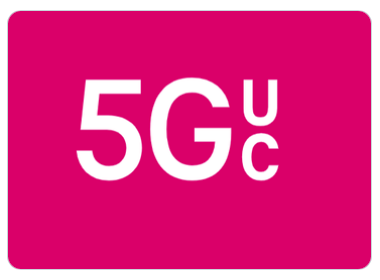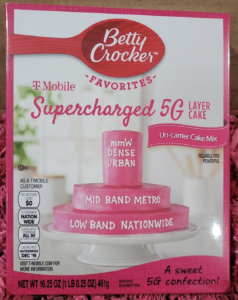Key Points:

Customers with T-Mobile 5G phones might notice something different this week - a new "5G UC" icon on their status bar.
This is T-Mobile's new way to notify customers when they are on T-Mobile's "5G Ultra Capacity" network, and not just connected via regular plain old boring 5G.
This new icon is rolling out this week to the new lineup of iPhone 13 models, and to iPhone 12s via the new iOS 15 software update. Android phones will likely get this update soon as well.
So does "5G UC" actually indicate anything worthwhile - or is this just a bunch of marketing nonsense?
Table of Contents
5G Cellular Indicators Explained Video
Subscribe to our YouTube Channel
T-Mobile’s Different Types of 5G

There are three different types of 5G spectrum - and not all flavors of "5G" are created equal. This is often referred to (particularly by T-Mobile) as the 5G layer cake.
At the top of the cake is mmWave spectrum - super high-frequency signals that can cary immense amount of super fast gigabit speed data, but which are also incredibly short-range.
mmWave signals are primarily being used to add capacity to airports, stadiums, dense retail areas, and core downtowns. But with a range measured in meters instead of miles, mmWave is something likely to be rarely encountered by most RVers and cruisers.
At the bottom of the cake is low band spectrum - mostly existing 4G spectrum being repurposed for 5G. When this spectrum is being used for 5G, it can at best deliver a "really good 4G" experience - but nothing truly next-generation feeling.
The mid-band spectrum is the sweet spot - usually providing a next-generation speeds, but without the extreme mmWave compromises.
Up until now - all of these layers have been lumped together under the "5G" label.
But T-Mobile has a big lead in rolling out mid-band spectrum, and it wants to show off that it has more truly next generation coverage than the other carriers.
So to do this - it is now programming phones to display the "5G UC" icon whenever there is mid-band or mmWave coverage in the area.
T-Mobile displays a regular "5G" notification when customers are on their low-band 5G spectrum.
Other Carriers’ 5G Notifications
T-Mobile is actually late to the party in tweaking what is displayed when connected to a 5G network.
Verizon and AT&T already provide notifications to their customers when they are on particular 5G bands.
Verizon uses an icon to notify customers when they are on what it calls the 5G Ultra-Wideband (5G UW) network, which is Verizon's mmWave/high frequency network. Customers will only see the "5G UW" icon in an area where 5G UW is available, and only when using a compatible device. Currently, Verizon 5G UW is only available in parts of select cities. You can see where it is available on their coverage map. Verizon customers on 5G other than their UW network will see just a 5G icon on their phone.
AT&T has three different "5G" network notification icons that they use. The "5GE" icon notifies customers when they are on AT&T's 5G Evolution network. But this 5GE is not a true 5G technology. The 5GE icon indicates the areas where the 4G network has been upgraded, and is "evolving" towards 5G. But behind the scenes, it is the same 4G LTE-Advanced technologies in use by all of the carriers.
AT&T's low-band 5G network is labeled just "5G" - and in most of the country it really does not give an experience any better than 4G.
AT&T's high-frequency mmWave network is referred to as "5G+", and a 5G+ icon will display on the phone or hotspot when customers are on that network. But again, 5G+/mmWave is only available in certain cities. You can read more about where it is available on AT&T's website.
Summary
With the different flavors of 5G that area available, it's nice that the networks are providing a way to notify customers when they are on a particular 5G performance tier.
And since there are different types of 5G, it's important to understand what they different icons mean. This will help you understand which 5G bands you're actually using.
Additional Reading Related News Stories







 Mobile Internet Resource Center (dba Two Steps Beyond LLC) is founded by Chris & Cherie of
Mobile Internet Resource Center (dba Two Steps Beyond LLC) is founded by Chris & Cherie of